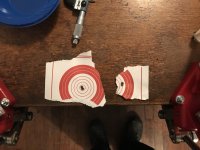jackie schmidt
New member
I figure you know as much, if not more than most on bullet stability and twist, so here is a question.
Lately, while hiding out at The Tomball Gun Club on Sunday’s, I have been shooting just about every thing I own. A few Sundays ago, I was shooting my HV 6PPC with the usual 66 grn bullets out of the Krieger 13.5 barrels.
On a whim, I decided to stick some 80 grn bullets in it, just to see. I first tried 4895, but could not get it to shoot that well. So Did a little math and figured about 27.5 grns of 133 might work.
It worked and then some.
Yesterday, I had my LV, same 13.5 Krieger, and tried the same load. I had to play with the tuner a tad, but soon had it shooting mid “ones” to small “twos”.
No pressure signs, easy bolt lift. I figure the velocity is around 3150.
From what I have understood, this should not be happening. The Bart’s 80 is a regular short range BT that measures around .945 inch long.
So, how close to the ragged edge am I on bullet stability. We looked close at the bullet holes, and they look perfect.
I kind of look at this combo as something to reach for when the regular 6PPC just refuses to cooperate. That is, unless bullets start going through the paper sideways.
Lately, while hiding out at The Tomball Gun Club on Sunday’s, I have been shooting just about every thing I own. A few Sundays ago, I was shooting my HV 6PPC with the usual 66 grn bullets out of the Krieger 13.5 barrels.
On a whim, I decided to stick some 80 grn bullets in it, just to see. I first tried 4895, but could not get it to shoot that well. So Did a little math and figured about 27.5 grns of 133 might work.
It worked and then some.
Yesterday, I had my LV, same 13.5 Krieger, and tried the same load. I had to play with the tuner a tad, but soon had it shooting mid “ones” to small “twos”.
No pressure signs, easy bolt lift. I figure the velocity is around 3150.
From what I have understood, this should not be happening. The Bart’s 80 is a regular short range BT that measures around .945 inch long.
So, how close to the ragged edge am I on bullet stability. We looked close at the bullet holes, and they look perfect.
I kind of look at this combo as something to reach for when the regular 6PPC just refuses to cooperate. That is, unless bullets start going through the paper sideways.



